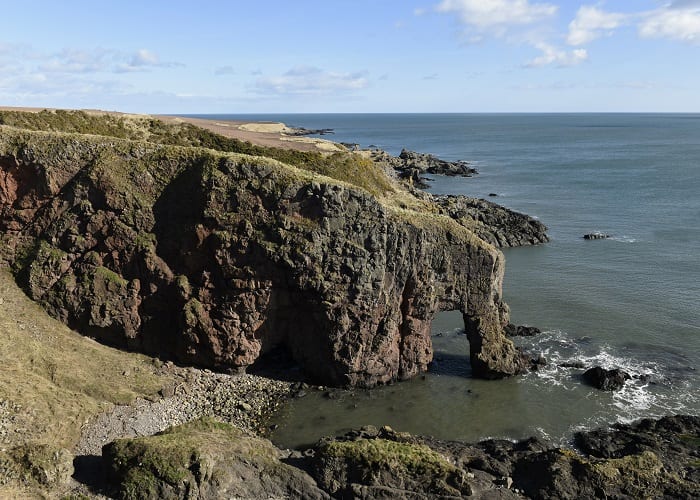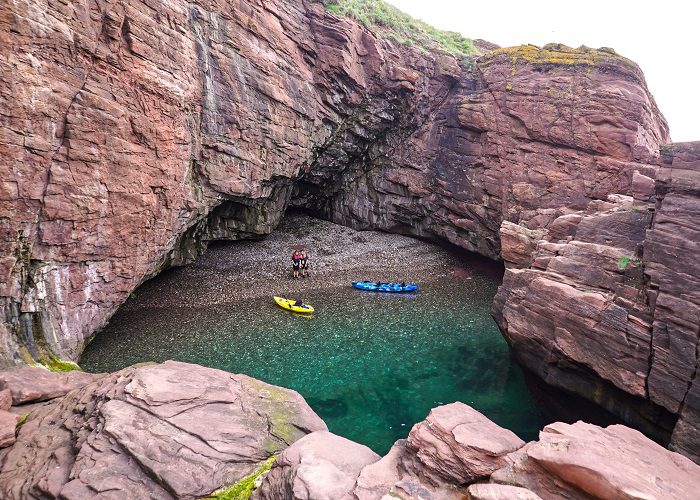In our latest blog, discover inspiring locations where you can enjoy nature at its best, including memorable woodland walks, stunning lochs, dramatic coastlines and the Angus Glens.
Throughout 2022, we will be sharing a series of blogs celebrating the Year of Stories.

As part of Scotland’s Year of Stories celebrations in 2022, we’re taking a look at how our encounters with nature are a constant source of wonderfully rich stories here in Angus.
If you’re looking for inspiring locations where you can enjoy the great outdoors and experience nature at its best, then look no further than Angus. With its memorable woodland walks, stunning lochs, dramatic coastlines, beautiful wildlife and, of course, the unforgettable Angus Glens, there is something for nature lovers of all ages and interests here.
There are many different ways you can explore the natural environment in Angus, from walking and hiking to running, cycling and even sailing. And, as the seasons change, so does the scenery, meaning you can come back to the same location on multiple occasions throughout the year, and no visit will feel the same as another.
There is an abundance of diverse wildlife to enjoy in Angus, from rare Alpine wildflowers and native woodland to iconic Scottish species such as bottlenose dolphins, adders, golden eagles and wildcats.
In this blog, we recommend just some of the most impressive locations and natural wonders that Angus offers to those who visit this beautiful, wild, and inspiring region of Scotland. Each inspiring location in our list has a unique story to tell too.
Six fascinating stories about how nature shaped our landscape
1. Elephant Rock
Elephant Rock is a naturally-formed coastal arch of volcanic rock nestled in a secluded bay that has been shaped by the elements over time. The name comes from the fact that the rock closely resembles the shape of an elephant’s head and trunk.
The route to Elephant Rock is a coastal walk with a difference. It features the grave of a man who apparently died 19 years before he was even born. When George James Ramsay was buried in the tiny cliff-top cemetery just north of Boddin Point, an error was made on the headstone. Beneath ‘In Memory of George James Ramsay’ the inscription on the sea-facing stone reads: ‘Born November 24, 1859, Died December 17, 1840’.
How this happened and why the memorial was never altered is a mystery. But it forms a fascinating part of a pleasant and accessible walk along the beautiful coastline from Boddin to Ferryden that offers breathtaking views across the North Sea.

Image: Elephant Rock
2. Corrie Fee
Hidden away at the end of Glen Clova lies Glen Doll, a spectacular glen carved by glaciers. And within Glen Doll, you’ll find Corrie Fee – a truly dramatic location and a National Nature Reserve. It is considered one of the most picturesque spots in Scotland; a massive bowl scooped out from the rugged mountainside by a glacier during the Ice Age.
Corrie Fee was created during intensely cold conditions about 12,900 years ago. As accumulated snow compacted into ice, glaciers formed in the area and started to grind out the bottom and sides of the corrie. This process eventually produced the steep, U-shape amphitheatre of cliffs you can see today.
The rocks that lie under Corrie Fee are around 600 million years old and are known as Dalradian rocks. Most Dalradian rocks in Scotland are acidic rocks derived from sands. Some of the rocks under Corrie Fee, however, are derived from less common muddier, lime-rich sediments and volcanic material.
This calcium-rich soil can support the ‘lime-loving’ plants that make the reserve such a fascinating place for botanists and nature-loving visitors. Pay Corrie Fee a visit to see all sorts of rare arctic-alpine plants that grow on the cliffs and wet flushes in the corrie. Some of these plants cannot be found anywhere else in the UK.
Botanists have known of the importance of the area since the 18th century. A memorial garden in Forfar pays tribute to the famous local botanist George Don and other local significant botanists who often spent time at Corrie Fee. George Don was a Scottish botanist and plant collector, born in Forfar in 1798. He spent much of his life exploring the corries and glens of Angus and further afield to Arran, Ben Nevis and Skye. He collected an impressive list of liverworts, lichens and mosses for a bryologist in the 21st century.

Image: Corrie Fee
3. Montrose Basin
Experts believe that a wave measuring 25 metres in height, travelling at around 80mph, battered the east coast of Scotland around 8,000 years ago. They refer to this as the Storegga tsunami event and believe that the wave directly impacted Montrose Basin, an enclosed estuary of the South Esk River. The water is estimated to have reached around 20 miles inland.
One theory is that the tsunami may have been triggered by an overload of sediment on the sea bed in the coastal shelf off Norway. And it’s this sediment that has been key to understanding the terrifying arrival of the giant wave.
In 2000, Dr Sue Dawson of the University of Dundee found wild cherry stones in the tsunami deposits, which indicated that the tsunami happened sometime in autumn. Fishbones and green moss have also been recovered from the sands.
Today, Montrose Basin is a designated nature reserve and a prime location to enjoy some of the very best scenery and wildlife on the east coast of Scotland. Covering 750 hectares, the Montrose Basin is home to over 80,000 migratory birds, including pink-footed geese, common terns, and kingfishers. In fact, from early September to late October, this is the best spot in Angus and one of the best places in Scotland to see pink-footed geese.
Four remote bird hides spread across the reserve offer the best locations to see some of these wonderful bird species for yourself. You may even spot a seal or two. The reserve includes a four-star visitor centre that offers something for nature lovers of all ages.

Image: Montrose Basin
4. Arbroath Cliffs
The Cliff Top trail in Arbroath offers four miles of stunning cliff-side scenery with dramatic cliffs, impressive blowholes, secluded beaches, and a variety of wildlife.
The cliffs include many fascinating rock formations that will appeal to those with an interest in geology and photography, as well as those who just want to admire a stunning coastline which demonstrates the power of the sea and the Scottish weather.
About half a mile from the start of the trail, you’ll find the Needle E’e (Needle’s Eye), a rock with a narrow hole cut through it. After that, the path curves left to loop above Dickmont’s Den, a deep, narrow inlet where the sea bubbles and froths below. Further on, you can’t miss the Deil’s Heid (Devil’s Head), an impressive sea stack with a very distinctive and menacing face.
The different evolutionary stages of the rocky coastlines can be clearly seen throughout these cliffs; faults and joints erode to form everything from minor gashes to large caves (Mason’s Cave). You can see phases of cave collapse from roof blowholes (caused by compressed air during storms), collapsed cave roofs (like Gaylet Pot) and natural arches. Complete roof collapse has formed elongate clefts called ‘geos’, including one called Dickmont’s Den.
The coastal path takes you from Arbroath to Auchmithie through Seaton Cliffs nature reserve – 1,850 acres of designated natural beauty where you can experience wonderful Scottish wildlife, including seabird colonies, butterflies, and wildflowers. The distinctive spotted burnet moth can be seen from June to August.
The cliffs are also one of the best locations in Angus to spot a bottlenose dolphin.

Image: Arbroath Seaton Cliffs
5. Arbroath Caves
The Arbroath coastline not only offers incredible cliffs and rock formations but also has extraordinary caves to explore, photograph and admire. The breathtaking natural sea caves and secret coves were formed by the erosive power of the sea carving into the red sandstone over many thousands of years.
One particular cave along the coastline is 400ft long and has impressive Stalactites on the ceiling, as well as its own sandy beach at one end. Some of the caves here have a mesmerising emerald green glow when the sun shines into the cave at just the right angle. This only happens in the caves where there is sand on the seabed, and it is breathtaking every single time.
As its name suggests, Smugglers’ Cave was once used to store illicit goods back when smuggling was rife all along the Angus coast. Smugglers used to spread stories about the caves being haunted in an effort to keep curious locals away from their hidden stash.
Close to the Smugglers’ Cave, you’ll find The Forbidden Cave. This particular cave has a daunting story to match its name. One stormy night, a man called Tam Tyrie took shelter in the cave with his wife and his dog. In an effort to drown out the sound of the wind and thunder, and possibly to keep their spirits up, Tam played some tunes on his bagpipes. But in the morning, all three occupants of the cave had disappeared. Meanwhile, a mile or so inland at a place called Dickmountlaw, a farmer swore that he later heard bagpipes playing a Highland song. Some say you can still hear bagpipes being played when underground in this area.
There are 12 caves to explore in total, but not all are easily accessible. If you’re exploring on foot, care must be taken in the caves at all times due to the tides, slippery and uneven surfaces, and changing conditions.
One of the most memorable ways to explore the caves is by taking an unforgettable kayak tour or guided wild swimming experience. People on these tours not only benefit from a unique perspective of the caves along the Angus coastline but have also been fortunate enough to spot bottlenose dolphins, harbour porpoises and minke whales near the coast.

Image: Arbroath Caves
6. Angus Glens
For some of the best wildlife experiences in Angus, head to the Angus Glens. People say that the glens of Angus (Isla, Doll, Clova, Prosen, Lethnot and Esk) spread out from Strathmore deep into the Cairngorms National Park like the fingers and thumb of a giant hand. Each glen has its own distinct character, and together they offer walkers, wildlife spotters, photographers, and nature lovers exceptional variety.
Glen Esk is the best place in Scotland to see adders, Scotland’s only snake species. Take the trail to Loch Lee in early spring and into summer, and you’ll find adders basking on roads and at the foot of walls when the sun is out. While these snakes are venomous, it’s rare for a person to get bitten. Adders are equipped to kill small prey animals like mice and voles. Once struck by the fangs, the prey will initially flee but soon succumbs to the venom. The adder follows the creature’s death trail and then swallows it whole.
Adders are timid creatures and have no desire for confrontation. The most common sight of an adder is usually a fleeting glimpse as the snake races for cover. You can also spot palmate newts and tadpoles in the ditches along the pathways of Glen Esk in late spring and early summer, when you also have a good chance of seeing osprey.
Glen Lethnot is a ground-nesting bird site. You’ll see black-tailed godwit in their beautiful orange-necked breeding plumage, numerous meadow pipits, as well as curlews, lapwings, oystercatchers, wheatears, buzzards and even cuckoos. Take a pleasant and rewarding walk through the glen to see red grouse around the valley sides and ravens soaring along the ridges of the valley. Look out for mountain hares amongst the clumps of heather too.
And in Glen Doll, you’ll be among iconic Scottish wildlife like golden eagles, Scottish crossbills, red deer and red squirrels. Wildcats are also known to inhabit the area but are quite elusive.
The Angus Glens combine to offer a rich blend of landscape, geology and natural habitat. The scenery is exceptionally varied, and the views are nothing short of awe-inspiring. There is an incredible variety of plants, birds and wildlife, including rare species such as the wildcat, red squirrel and pine marten.

Image: Glen Prosen
These locations are just a small selection of the natural wonders that Angus has in store. We hope this inspires you to come to Angus and explore this rich and varied place for yourself.
There is something special and life-affirming about spending time in the natural environment, especially in this beautiful part of Scotland, so why not plan your visit to Angus today.




